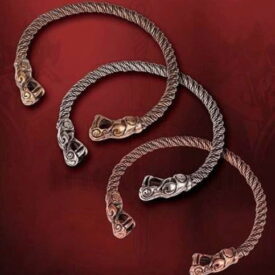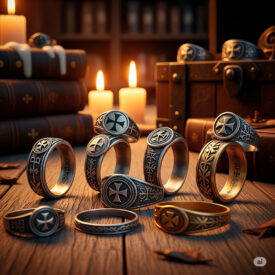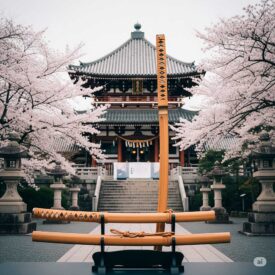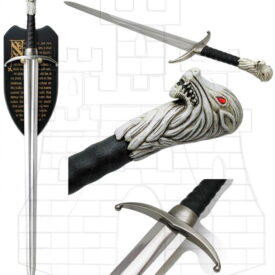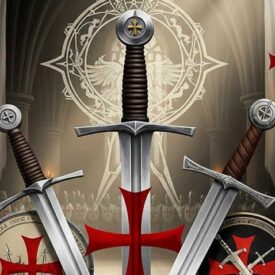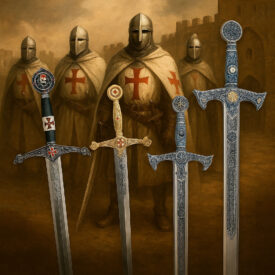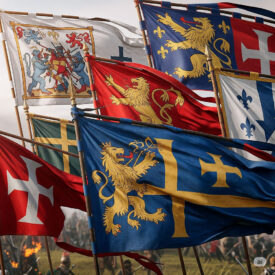Imagine the roar of battle, the clash of steel echoing through the rugged valleys of Scotland! In the heart of this untamed land, a weapon emerged that not only forged victories but also sculpted the spirit of a nation: Scottish swords. From the colossal greatswords that defended Highland freedom to the agile basket-hilted swords that graced the hands of brave warriors, each of these pieces tells an epic tale of resistance, honor, and pride. Are you ready to delve into the fascinating history of these legendary battle companions?
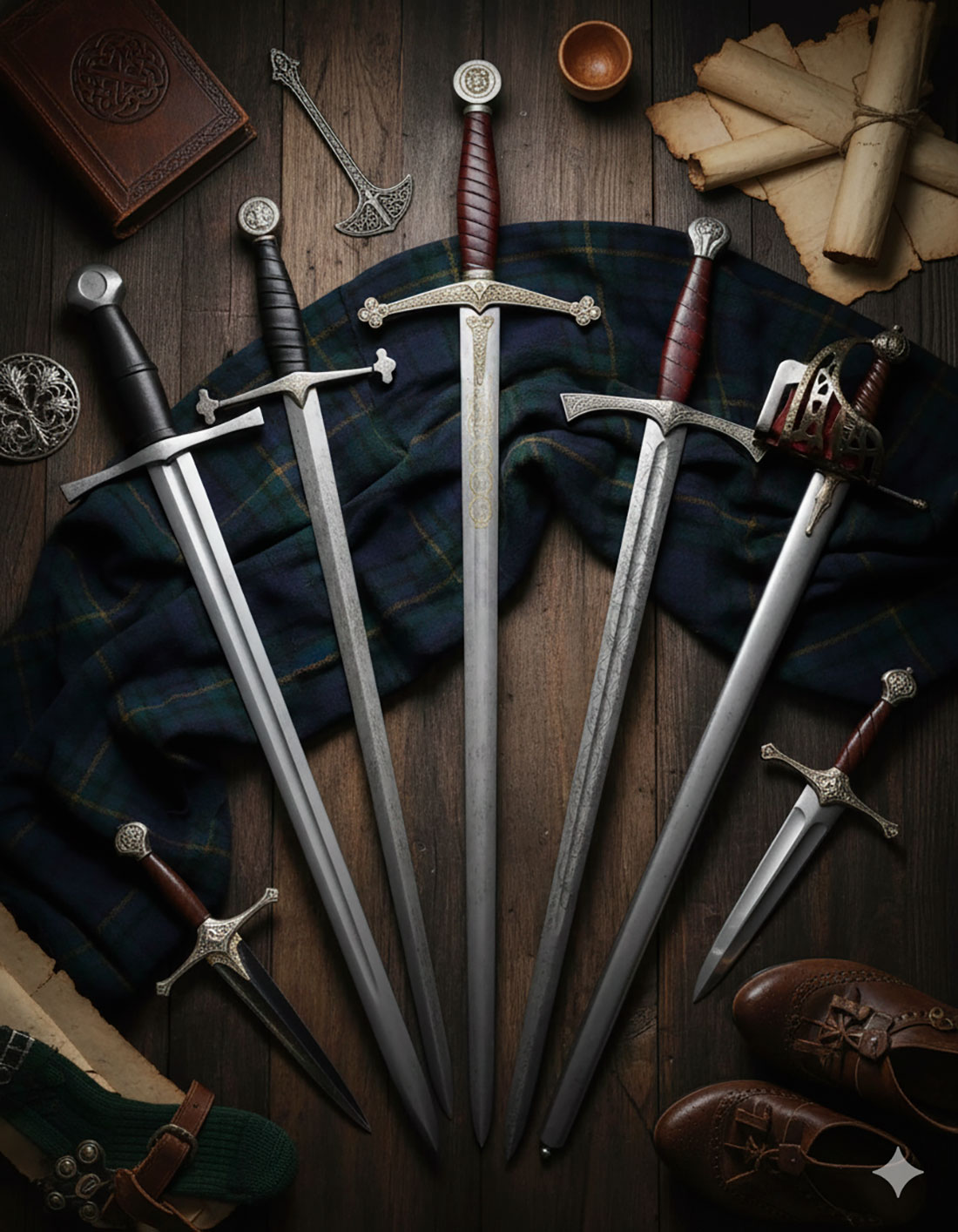
The Claymore: More than a Sword, a Symbol of Scottish Freedom
When we speak of Scottish swords, we inevitably refer to the majestic Claymore. This is not a mere weapon; it is a standard of independence and a cultural icon that has transcended battlefields to take root in the heart of Scotland. The term, an Anglicization of the Gaelic Claidheamh Mòr, meaning “great sword,” embodies the essence of its formidable presence.
The Highland Claymore, an imposing two-handed sword, emerged in the late 15th century, perfected in the 16th century to become a devastating force on the battlefield. With lengths often exceeding 120 cm and even 180 cm and a considerable weight of over 1.5 kg, this sword was the preferred choice of Scottish Highlanders. Its design, with a characteristic cross-shaped quillon (guard) and trefoil terminations, not only protected the warrior but also instilled fear in enemy ranks. Its primary purpose was clear: to break English pike formations and sow chaos, demonstrating its effectiveness in the rugged terrain of the Highlands.
Chronology of Scottish Swords: A Journey Through Time
| Era | Event |
|---|---|
| Medieval Origins and Two-Handed Claymore | |
| 13th Century | Background: Scottish Highlanders wielded great swords in the fight against English invaders. |
| Late 15th Century | Origin of the Claidheamh Mòr (Claymore) as a montante or two-handed greatsword, adapted from large European swords. |
| 16th Century | Culminating point in Claymore development: blades became shorter and lighter to improve balance and maneuverability. |
| 15th–17th Centuries | Period of development and use as a significant war weapon in the Highlands; typical lengths between 1.2 and 1.8 m (4–6 feet). |
| Appearance of the Basket-Hilt Broadsword | |
| Late 16th / Early 17th Century | Introduction of the “Lowland Claymore” or basket-hilted sword: a one-handed weapon with a basket-shaped guard and a shorter, lighter blade. |
| Conflicts and Developments in the 17th–18th Centuries | |
| 1644 | Battle of Tippermuir: Highlanders armed with Claymores contribute to a decisive victory. |
| 1689 | Battle of Killicrankie: Highlanders, with their Claymores, prove decisive against English troops. |
| 1690s | The design of the basket-hilted sword is attributed to John Simpson, a freeman of the Hammermen of Glasgow. |
| 1715 and 1745 | Widespread use of the basket-hilted broadsword by supporters of the House of Stuart in the Jacobite risings. |
| 1730s–1740s | Another John Simpson popularized the design while serving as a royal armorer; in the Jacobite era, this variant was probably the most common even in the Highlands. |
| 1746 | Battle of Culloden: the broadsword style is associated with Culloden (sometimes called “Culloden Sword”); after the defeat and the proscription laws, its military importance declined. |
| Transformation into a Military Symbol and Terminological Changes | |
| Late 18th Century | Due to military reforms, the basket-hilted sword became an emblem for Highland regiment officers; it also influenced the design of the 18th-century cavalry saber. |
| 19th Century (Victorian Period) | Terminological change: the term “Claymore” began to be applied exclusively (and somewhat anachronistically) to the large two-handed sword, causing confusion with its previous use for the basket-hilted sword. |
| Terminological Context and Supplementary Data | |
| Terminology and Characteristics |
|
William Wallace’s Greatsword: A Legendary Weapon
When history invokes the name of William Wallace, the image of a colossal warrior wielding an equally monumental sword comes to mind. Although the sword preserved today in the National Wallace Monument is Germanic in cut and not a traditional Claymore, it embodies the spirit of these great Scottish swords. At 1.67 meters long and weighing over 2.5 kg, this piece demanded extraordinary strength and dexterity, a true greatsword worthy of a leader who defied the English invasion.
In combat, the technique with these swords was unique. It was believed that the warrior could hold the blade with one hand (protected by a sturdy glove) to deliver quick thrusts, while the hilt served for blunt strikes. Its greatest advantage lay not only in its edge but in its ability to inflict devastating blows due to its weight and to keep multiple opponents at bay with wide swings.
The Basket-Hilted Broadsword: Agility on the Battlefield
While the two-handed Claymore dominated the Highlands, another variant of Scottish sword, the basket-hilted broadsword, sometimes known as the Lowland Claymore, gained ground in the 17th century. This one-handed weapon featured a shorter, lighter blade, ideal for a faster, more precise fighting style. Its most distinctive feature was its basket-shaped guard, an ingenious hand protection that offered a crucial advantage in the tumult of battle.
These swords were massively produced in Glasgow, and their design is attributed to armorers like John Simpson. Their popularity grew during the Jacobite risings, becoming an emblem for officers of Highland regiments. The variety is notable, including the “lantern sword” with its intricate hilt and symmetrical bowl, a testament to the period’s artisanal skill.
The Claymore Today: An Enduring Symbol
Although the era of great battles is long past, the spirit of the Claymore and other Scottish swords endures. Today, these weapons have transcended their warlike function to become powerful cultural symbols and objects of fascination. They represent national resilience and pride, the rich heritage and tradition of the clans, and a unique cultural identity celebrated in ceremonies, historical events, and in the art of collecting. Replicas of these meticulously crafted swords allow enthusiasts worldwide to own a piece of legendary Scottish history.
Clarifying Doubts about the Claymore and its Scottish History
What is the main difference between the Highland Claymore and the Lowland Claymore?
The main difference between the Highland Claymore and the Lowland Claymore lies in their design, origin, and cultural use.
- Highland Claymore: This is a large two-handed sword, traditionally associated with the Gaelic clans of northern and western Scotland. It is characterized by its cross-shaped guards with open trefoil terminations, angled towards the blade. This weapon was primarily used between the 16th and 17th centuries in the context of internal struggles and border conflicts.
- Lowland Claymore: Although the term “claymore” has also been used for one-handed swords with a basket hilt, in the context of the Lowlands, it refers to the two-handed sword typical of southern Scotland. Its characteristics differ slightly, with details in the hilt and blade adapted to the reality of the lowlands, but it remains a large sword.
 Summary: The Highland Claymore is the quintessential two-handed greatsword, a symbol of Gaelic warrior culture and the northern clans; the Lowland Claymore is also a two-handed sword, though less emblematic in popular culture, and reflects a regional variant more influenced by contact with continental Europe. The term “claymore” can lead to confusion, but the fundamental distinction is geographical, cultural, and, to a lesser extent, in design.
Summary: The Highland Claymore is the quintessential two-handed greatsword, a symbol of Gaelic warrior culture and the northern clans; the Lowland Claymore is also a two-handed sword, though less emblematic in popular culture, and reflects a regional variant more influenced by contact with continental Europe. The term “claymore” can lead to confusion, but the fundamental distinction is geographical, cultural, and, to a lesser extent, in design.
What does the Claymore symbolize in current Scottish culture?
The Claymore symbolizes several important aspects in current Scottish culture:
- Resistance and National Pride: It represents the historical resistance of the Scottish people, especially against English domination, and continues to be a symbol of national pride.
- Heritage and Tradition: It is a symbol of family heritage and Scottish clans. Swords were often passed down from generation to generation, accompanied by stories and traditions.
- Cultural Identity: Along with other national emblems such as the kilt and the thistle leaf, the Claymore is an iconic cultural element that reflects Scottish identity.
- Ceremonies and Historical Events: It is used in ceremonies, films, and historical events to represent the Scottish cultural legacy.
How did the Claymore influence battles between Scotland and England?
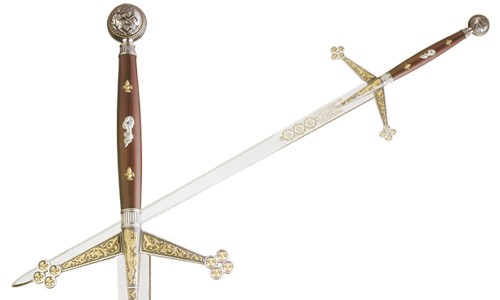
The Claymore decisively influenced battles between Scotland and England by being a lethal and symbolic weapon for Scottish warriors, especially in close combat where its large size and strength allowed it to penetrate armor and defeat multiple adversaries at once. It was fundamental in several historical Scottish victories, such as the Battle of Killicrankie (1689) and the Battle of Stirling Bridge (1297), where the Scots used their Claymores to defeat and inflict heavy casualties on English troops. Furthermore, it was central to the formation, tactics, and morale of Scottish warriors, representing their resistance and unity against England.
What characteristics make the Claymore a unique weapon compared to other European swords?
The Claymore is unique compared to other European swords due to its design as a long, double-edged sword used with both hands, with a total length often exceeding 150 cm and a considerable weight that demands strength and dexterity. Its most distinctive feature is the guard with arms curved forward and often terminating in a four-leaf trefoil shape, which not only protects the hand but also allows for catching or deflecting enemy weapons. Additionally, its long grip and large pommel act as a counterbalance, facilitating powerful and controlled strikes.
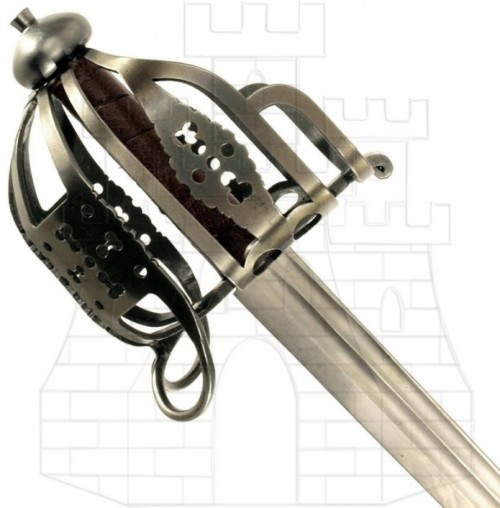 Unlike other continental swords that tend to be more specialized, the Claymore maintains great versatility for cutting and thrusting, suitable for combat in difficult terrain and the fighting style of Scottish clans. Its robustness and design make it an emblematic weapon, representing both the cultural identity and the combat effectiveness of Scotland.
Unlike other continental swords that tend to be more specialized, the Claymore maintains great versatility for cutting and thrusting, suitable for combat in difficult terrain and the fighting style of Scottish clans. Its robustness and design make it an emblematic weapon, representing both the cultural identity and the combat effectiveness of Scotland.
What role did the Claymore play in the Scottish struggle for independence?
The Claymore played a crucial role in the Scottish struggle for independence, as it was an effective weapon on the battlefield and a symbol of resistance against English rule. Developed in the 15th and 17th centuries, this two-handed sword was used in various battles during the Scottish Wars of Independence, such as those of Stirling and Bannockburn.
The Claymore not only provided tactical advantages due to its ability to penetrate armor but also became an emblem of Scottish culture and valor, transcending its function as a weapon to become a powerful symbol of national identity and pride. Furthermore, it was an integral part of the Scottish clan system, where it was passed down from generation to generation as a family heirloom and a symbol of status.
Scottish swords, in all their forms, are much more than simple weapons; they are relics that encapsulate centuries of history, battles, and the indomitable spirit of a nation. From the Highland Claymore to the basket-hilted broadsword, each of these pieces invites us on an epic journey through time, reminding us of the bravery and mastery with which they were forged.
